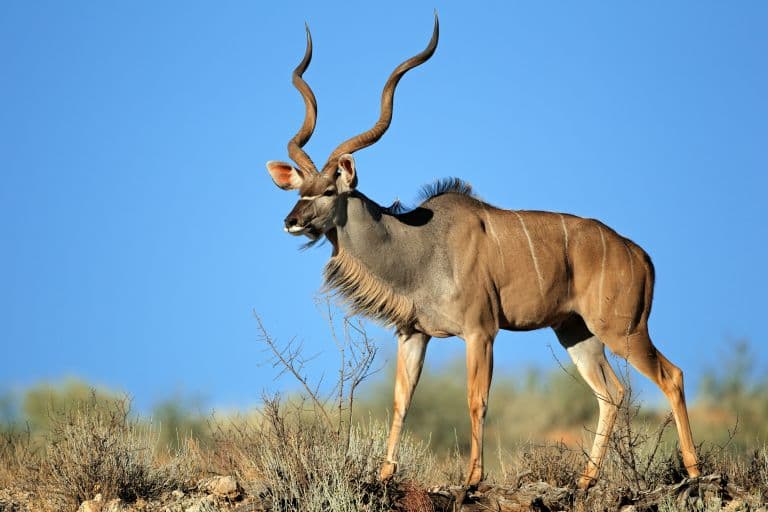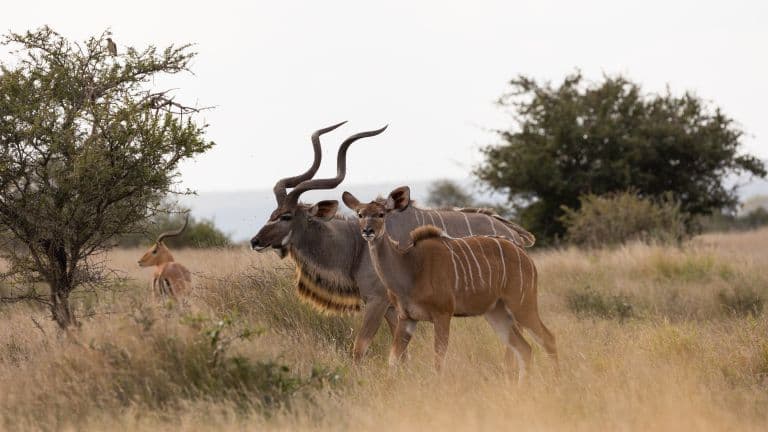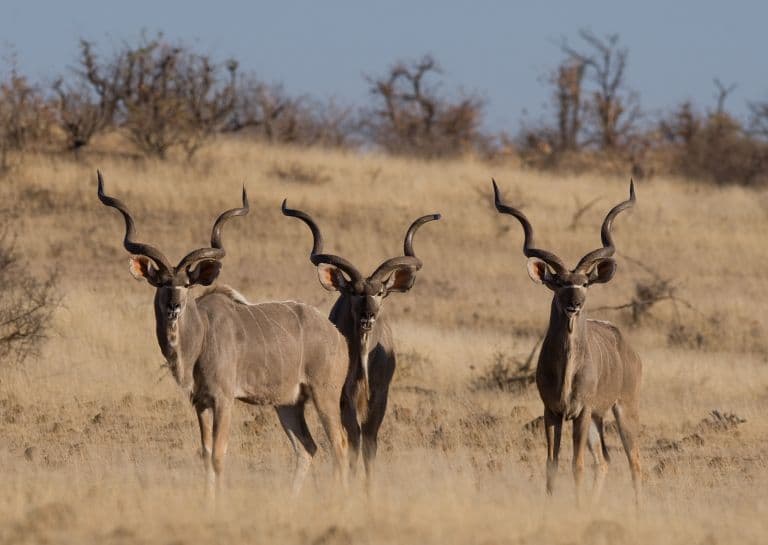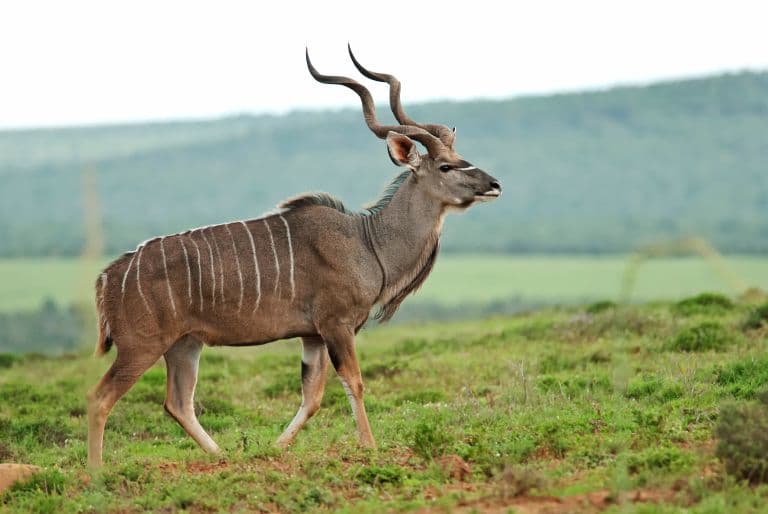Kudu Profile
Antelopes are an interesting type of animal. While they’re actually bovids, most of them look a lot like deer, and that’s because they fill a similar niche.
In Africa, there are over 70 species of antelope (and only one species of deer) and many of them are hard to tell apart; many species of gazelle can only be differentiated by the way their bums wiggle. [This is partly true!]
The Kudu, on the other hand, is quite an easy one to recognise. Aside from being a brand of Dutch phone covers, they’re also one of the most magnificent antelope in Africa, with distinctive horns and colouration which make them a great entry-level antelope.
There are two species of Kudu – the greater and lessser kudu, and while their appearance is similar, greaters are larger than their lesser counterparts.

Kudu Facts Overview
| Habitat: | Savanna, grasslands |
| Location: | Northeastern, East and Southern Africa |
| Lifespan: | 8 in the wild, 23 in captivity |
| Size: | 187.64 cm (73.87 in) long, 160 cm (63 in) tall |
| Weight: | Up to 315 kg (694 lb) |
| Colour: | Grey-brown with vertical, thin white bands |
| Diet: | Leaves, flowers, fruits, tubers and shoots, grasses, herbs and vines |
| Predators: | Lions, spotted hyenas, and African wild dogs, leopards, humans |
| Top Speed: | 48 kph (30 mph) |
| No. of Species: | 2 |
| Conservation Status: | Least Concern (Greater kudu) Near Threatened (lesser Kudu, IUCN) |
The kudu is part of one of the prettiest genera of antelope. This genus contains the bongo, known for its contributions to drum circles, and its close relatives, the sitatunga, bushbuck and nyala.
They occupy savanna near Acacia and Commiphora shrubs, where they are camouflaged, hidden in the bush and thickets. They are browsers and will eat leaves, shoots and fruit.
The Greater and Lesser kudus aren’t as closely related as their names suggest, but like many of their kind, they have characteristic vertical stripes and impressive horns.
They’re also massive. All this makes them great to spot, easy to identify and reduces the embarrassment of misidentifying one as a deer.
Interesting Kudu Facts
1. They’re one of the largest antelope
Lesser kudus are around 1.5m long at the high end, and just over a meter tall. This isn’t exceptional for an antelope, but with their spiralled horns, vertical stripes and bushy tail, they fairly closely resemble the much larger, greater kudu.
And this is a very large antelope. Again, it has spiral horns, thin, vertical white stripes, and stands up to 1.6m tall. A big male greater kudu could weigh up to 315kg, which sets them apart from most of the antelopes on the continent, including the large and shaggy bushbuck.
But even as one of the largest, it’s a far cry from the top. Giant eland females can weigh up to 600kg – almost twice as much as a male kudu. And the males have been known to reach 1,200kg!
The Elands take the top two ranks, but third place goes to the Kudu’s close cousin, the Bongo. After which the Kudu itself comes in at the fourth-heaviest. 1

2. Male kudu have the largest horns of any antelope species
Males known as ‘bulls’ have spiral horns, which can reach up to 180cm in size (just under 6 feet!).
These are the largest horns of any antelope species. Females, known as cows do not have horns in either kudu species.
They start to grow between 6-12 months of age, and are fully formed at around 6 years old.
They help tell the age of the kudu, as the first spiral rotation appears at around 2 years, with two and half spiral rotations not appearing until 6 years old. Occassionally they can have 3 turns!
3. They’re anarchists
Lesser kudus have an interesting social structure. There’s no sign of a leader or even a hierarchy, and they don’t display territorial behaviour. Fights within the herd are rare and only involve a little bit of pushing and shoving.
On the other hand, they’re not particularly into one another, either. They rarely groom one another and appear only to form close bonds during breeding, between a handful of females and their young. Outside of this, they exhibit the kind of aloofness you’d expect from being designated the title of “lesser” kudu.
Even the males have overlapping ranges, often with four or five bulls in the same zone.
As a whole, these are pretty unsociable animals who don’t associate with other species and don’t really pay all that much attention to one another, either.
Greater kudus are a little bit more interesting. Females do form small groups, or maternal herds, sometimes up to 20, and males are generally more boisterous and therefore solitary.
4. Their necks get fat
Sometimes, males will form roaming bachelor groups, much like the kind from the UK that are now banned from Amsterdam and the Balearics.
Except even this tonnage of testosterone is relatively tame in comparison to English tourists, and threat displays are short-lived and empty.
Male kudus present another characteristic that aligns with their pinker human analogues: during the mating season, their necks get thicker. It’s not clear how this happens – whether it’s hypertrophy or increased blood flow – but it’s thought that it might have something to do with reinforcing the musculature for their horns during the rut.
This is something seen in male deer, for the same reason, and in the greater kudu, it likely gives the male better chances when it comes to a face-off.
During these rare physical conflicts, males will establish who can pull the hardest, and the winner gets the top breeding rights.
That is if he can detach himself from the loser.

5. Kudu can die due to locked horns during sparing
These ceremonial interactions have evolved to be a lot less costly than a full-on battle, and so there’s a tragic irony that sometimes they’re even more fatal.
Sparring is rare as it is, but when it happens, horns interlock and spirals fix the rivals in place. When an animal concedes defeat, he presents a lateral display; standing perpendicular to the winner to signal that the bout is over.
But this can only happen if the horns can come apart, and on occasion, they get so jammed together that separation is impossible. If this happens both animals will dehydrate and die.
Other times, the loser is particularly unlucky and suffers a fatal defeat, and the winner is doomed to stay affixed to his victim until he tires and succumbs himself.
This “death twist” is remarkably rare, and kudus, like many animals who gnaw on roughage their whole lives, are more likely to die when their teeth become too worn to function and they starve to death.
As brutal as this is, it’s a good sign that the species can avoid predators well enough to last that long. 2
6. They’re hard to kill
Lesser kudus aren’t very fast. They’re not very energetic, either, and wouldn’t have the endurance to outrun any of their main predators, even if they did have the speed to.
What they have is surprisingly good camouflage, a life-saving shyness, and the ability to jump into bushes that outclasses even the most vigilant guerrilla skateboarder.
This defence mechanism has led to it surviving not only its natural enemies but also increasing human predation, and hunters find it a tricky target to catch.
Still, this is a species that is now considered Near Threatened, and their populations are in decline.
Greater kudus are doing better, despite being heavily hunted, but their population trend isn’t known. 3 4

7. They have a complicated relationship with people
Much of what humans do isn’t beneficial to the kudu. Their horns are used as instruments and containers for food. Other parts are used ritualistically. Their meat and hides are used in the ways that meat and hides are commonly used and their grazing grounds are being turned into farmland.
But, as humans create new fertile landscapes by bringing water to arid areas, the kudu finds its range expanding.
It’s unlikely that this is a net gain for the species, but it does provide some hope for their protection.
8. Kudu meat is claimed to produce the best biltong
Kudu meat is eaten in various African countries. Their meat is similar to that of venison and very lean, with a gamey flavour.
Kudu meat is also used for biltong, which is a form of dried, cured meat that originated in Southern Africa. Other animals such as beef and ostrich are also used to produce biltong snacks.
9. There are conservation efforts for Kudu
Organisations like the African Wildlife Foundation strive to engage governments to manage these factors intelligently with animals like the Kudu in mind.
The aim is to balance conservation with modernisation and use ecotourism as leverage. If local stakeholders can benefit directly from conservation efforts, incentives align to protect species like the kudu from the ravages of human development. 5

10. Their dung is used in a sport appropriately named ‘Kudu dung-spitting’
No really.
‘Bokdrol Spoeg’ in Afrikaans is a ‘sport’ (apparently) which is practiced by the Afrikaner community in South Africa. This involves spitting small hard kudu dung pellets from the mouth to see which travels the furthest – and wins the competition.
In 1994, a world championship was established, with competitions held at community events, game festivals, and tourism exhibits.
Shaun van Rensburg Addo set the world record for kudu dung-spitting at 15.56m in 2006.
Congratulations, Shaun! We think.
Kudu Fact-File Summary
Scientific Classification
| Kingdom: | Animalia |
| Phylum: | Chordata |
| Class: | Mammalia |
| Order: | Artiodactyla |
| Family: | Bovidae |
| Subfamily: | Bovinae |
| Genus: | Tragelaphus |
| Species: | Tragelaphus Imberbis (Lesser Kudu) Tragelaphus Strepsiceros (Greater Kudu) |
Fact Sources & References
- Simpson, C (1968), “Reproduction and Population Structure in Greater Kudu in Rhodesia”, Sci Hub.
- (2015), “In photos: Male kudus lock horns in a fatal battle”, EARTH TOUCH NEWS.
- “Greater Kudu”, RedList.
- “Lesser Kudu”, RedList.
- “What is a kudu?”, African Wildlife Foundation.
